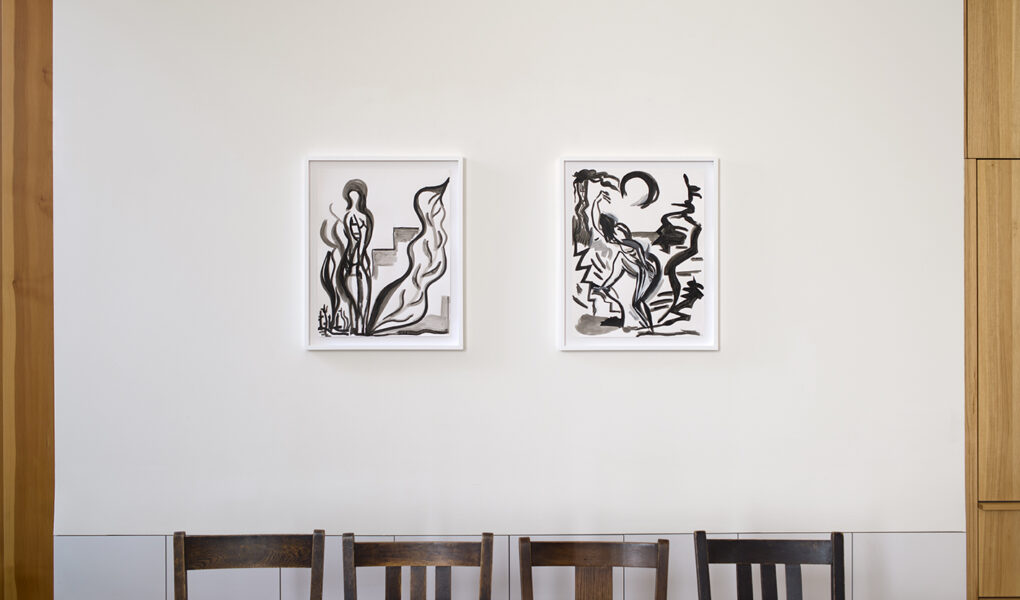by Carlin Brown
Originally published March, 2019

The entrance to the lumber room’s lower level glows a flush pink. The unexpected color dissipates in the stairwell approaching the lumber room’s main gallery, called the yard, where a wall of windows and multiple skylights fill the space with sprawling pools of bright sun. On view is Mira Dancy’s solo exhibition, Self Seed. (The exhibition was on view from April 13 to June 16, 2018.)
At the top of the stairs, the wall sculpture Self Seed (2018) emits purple light from a neon drawing affixed to black reflective acrylic. The neon, spelling out the show’s title, is an invitation. Its color matches the bluish purple of lavender stems that are tucked into envelopes with a card of poetry for visitors to take away. Lavender is self-seeding; it drops its sweet, fragrant pods full of seeds at the end of growing season, trusting the natural cycle of rain and sun to germinate and regrow in perpetuum. Fallen seed pods dry and shatter, but as their shells crack, another sprout grows. The envelopes are dispersed as remnants of the exhibition, spreading Dancy’s poem like seeds caught in the wind.
For Self Seed, Dancy created two new murals and two other site-specific artworks: Herfume (2018), a smoky grey vinyl that spells “herfume” on one of the yard’s central windows; and Herfule (2018) where the word “herfuel” is carved out of black sand on the floor. These two works embrace the lumber room’s architecture. Sand is arranged in a semi-circle around a wooden column, aligning with the outer points of Herfume’s windowpane. Other works were brought to Portland from Brooklyn, where Dancy is based. Ten framed drawings are mounted at the lumber room, starting downstairs with Three Deep (2018) and spilling into the living quarters where Self/Seed/Stair (2018) and Natural Goodbye (2018) hang above the dining table.

The lumber room has a history of inviting artists to create artworks that are temporary and site-specific, enmeshing exhibitions and public events inside the private residence. Founder Sarah Miller Meigs encourages artists and guest curators to install artworks in the dining room, on the outdoor patio, or even in the shower, as was the case for D’ette Nogle’s video For all the Artists (2015) in the group exhibition Open Sesame . In fall 2017, Los Angeles-based artist Eve Fowler produced ROSE.ROSE.ROSE.UP. fitted to the exact span of three large windows, for the evolving exhibition Women to the Front. Other site-specific works are permanently or semi-permanently installed at the lumber room, like Léonie Guyer’s oil-on-wall painting Constellation (no. 1), which has occupied the wall at the beginning of the stairs up to the lumber room’s main space, since its inaugural exhibition in 2010. Other paintings and drawings by Guyer are scattered throughout the lumber room; together, they inspired the group exhibition Interior Margins . Some of Guyer’s paintings have quietly appeared in every exhibition at the lumber room to date, including Self Seed.

In Dancy’s drawings, black ink sinks infinitely into paper while acrylic paint in Dayglo pink and lipstick red sits above its surface. Each work on paper presents a woman (sometimes, several women) clad in high-heel shoes, thigh-high stockings or lingerie, posing, shackled, or engulfed by flames. In one particular drawing, Give Yourself (2018), the alluring figure wears a sexy red dress with matching purse and nail polish while using an ATM. The works entwine female experience with commodity, erotic fantasy, and, especially, trauma. Dancy’s brush strokes recall early German expressionism, where dark and angular visuals capture psychological distress in the wake of political tyranny. Her work contains the same twisting marks to imbue her drawings with a theatrical anguish, revealing pain behind the stoicism. Dancy’s women flourish and multiply, standing up to say “Me Too” with confident vulnerability.
In the mural Splintered Shadow (2018), shadows grow toward the ceiling while rows of women seem to emerge from water with their fists risen in cold defiance; their eyes are sunken and tired, yet they continue on their march. Dancy asserts her female figures as simultaneously commanding and tender. A resilient perennial, lavender is

both delicate and invasive, a symbol of elegance that spreads from just one small plant to an army of purple stems. Once picked and dried, the flower’s seductive floral scent lasts for decades, holding on to its femininity even in death.

. Open Sesame was a group exhibition of international video artists curated in 2016 at lumber room by Kristan Kennedy, Artistic Director and Curator of Visual Art at the Portland Institute for Contemporary art.
. Interior Margins was a group exhibition curated in 2011 at lumber room by Stephanie Snyder, John and Anne Hauberg Curator and Director, Douglas F. Cooley Memorial Art Gallery, Reed College in collaboration with lumber room founder Sarah Miller Meigs.
Carlin Brown is a Canadian artist and writer based in Portland, Oregon.
This essay was edited by Stephanie Snyder, and is among a series of writing commissioned by The Ford Family Foundation’s Critics and Curators Program, with founding Editors Stephanie Snyder, John and Anne Hauberg Curator and Director, The Douglas F. Cooley Memorial Art Gallery, Reed College; and Sue Taylor, Professor Emerita of Art History, Portland State University. The commissioning institutions share a goal to strengthen the visual arts ecology in Oregon, and a key interest of increasing the volume of critical writing on art in our region.
